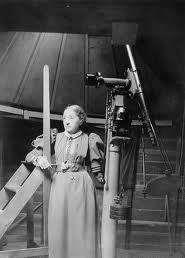Elizabeth Brown (astronomer) facts for kids
Elizabeth Brown (born August 6, 1830 – died March 5, 1899) was a British astronomer. She was also a Quaker, a member of a Christian group known for its simple lifestyle. Elizabeth was especially interested in studying the Sun, focusing on sunspots and solar eclipses.
She played a key role in starting the British Astronomical Association. She was also one of the first women to become a Fellow of the Royal Meteorological Society. This shows how important she was in the world of science during her time.
Contents
Early Life and Science Beginnings
Elizabeth was born and lived in Cirencester, a town in Gloucestershire, England. Her father, Thomas Brown, was very interested in science. He taught Elizabeth about observing the Sun, including how to watch sunspots. He also taught her to measure weather, like rainfall.
Elizabeth took over her father's weather observations in 1871. She continued this work until he passed away in 1883. After her father's death, she had more freedom to travel. She began to journey around the world to observe solar eclipses. She even wrote two books about her travels, but she published them without her name.
Becoming an Astronomer
After her father died, Elizabeth joined the Liverpool Astronomical Society. At that time, this society was for amateur astronomers across Britain, not just in Liverpool. Elizabeth traveled 140 miles round trip from Cirencester to Liverpool to attend meetings.
Soon after joining, she became the director of the society's Solar Section. This meant she was in charge of all the work related to observing the Sun for the group.
Founding the British Astronomical Association
Elizabeth Brown was very important in setting up the British Astronomical Association (BAA) in 1890. This new group aimed to help amateur astronomers work together. She became the Director of the BAA's Solar Section, a role she held until her death in 1899.
She also helped with other parts of the BAA's work. This included sections that studied the Moon, stars that change brightness, and stars with different colors. After Elizabeth passed away, her sister, Jemima, also joined the BAA. Jemima took care of the special astronomical tools Elizabeth had given to the Association.
The British Astronomical Association welcomed women as members from the very beginning. This was different from the Royal Astronomical Society, which did not accept women members easily. In 1892, Elizabeth Brown was one of three women suggested to become a Fellow of the Royal Astronomical Society. However, they did not get enough votes to be elected. Despite this, Elizabeth was elected to the Royal Meteorological Society in 1893.
Traveling for Eclipses
Elizabeth Brown traveled widely to chase solar eclipses. She wrote about these exciting adventures in her book, In Pursuit of a Shadow, published in 1887. The book's title was inspired by another Quaker scientist, Luke Howard, who used a similar phrase to describe his work on clouds.
Her second book of travel stories, Caught in the Tropics, came out in 1890. Elizabeth was also known for her daily records of sunspots. She made very careful drawings of them, which earned her a great reputation among scientists.
See also
 In Spanish: Elizabeth Brown para niños
In Spanish: Elizabeth Brown para niños


